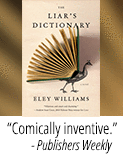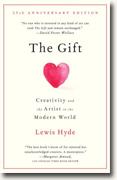The Gift
Lewis Hyde
book reviews:
· general fiction
· chick lit/romance
· sci-fi/fantasy
· graphic novels
· nonfiction
· audio books
· author interviews
· children's books @
curledupkids.com
· DVD reviews @
curledupdvd.com
newsletter
win books
buy online
links
home
for authors
& publishers
for reviewers

 |
The Gift: Creativity and the Artist in the Modern World Lewis Hyde Vintage Paperback 464 pages December 2007 |
|
The cover copy calls Lewis Hyde’s The Gift
“It is the assumption of this book that a work of art is a gift, not a commodity… a work of art can survive without the market, but where there is no gift, there is no art.”The dilemma for artists in our materialistic world is how to continue creative pursuits while paying the rent. It’s not unusual to find artists neglecting the rare and genuine gifts they could share in favor or more generic – therefore more marketable — shadows of genius. The difference between an artistic gift and a commercial product is generally determined by the source of its creation. “An essential portion of any artist’s labor is not creation so much as invocation. Part of the work cannot be made…” but must be received from some fickle muse. “Not all artists use these very words, but there are few artists who have not had this sense that some element of the work comes to them from a source they do not control.” Several sub-titles have been attached to The Gift Drawing from psychology, anthropology, and even economics, Hyde provides the raw material of understanding. The finished products is a true gift, given to those who create as a way of understanding the artist’s vital role in society, and stimulates the intuitive acknowledgement that readers experience on their own. Originally published on Curled Up With A Good Book at www.curledup.com. © Deborah Adams, 2009 |
|
|
|
 Click here to learn more about this month's sponsor! |
|
| fiction · sf/f · comic books · nonfiction · audio newsletter · free book contest · buy books online review index · links · · authors & publishers reviewers |
|
| site by ELBO Computing Resources, Inc. | |
 Like most creatives, Hyde has cause to ponder the rift between art and the commercially-driven world in which we live. In the introduction to this 25th-anniversary edition, Hyde tells us
Like most creatives, Hyde has cause to ponder the rift between art and the commercially-driven world in which we live. In the introduction to this 25th-anniversary edition, Hyde tells us